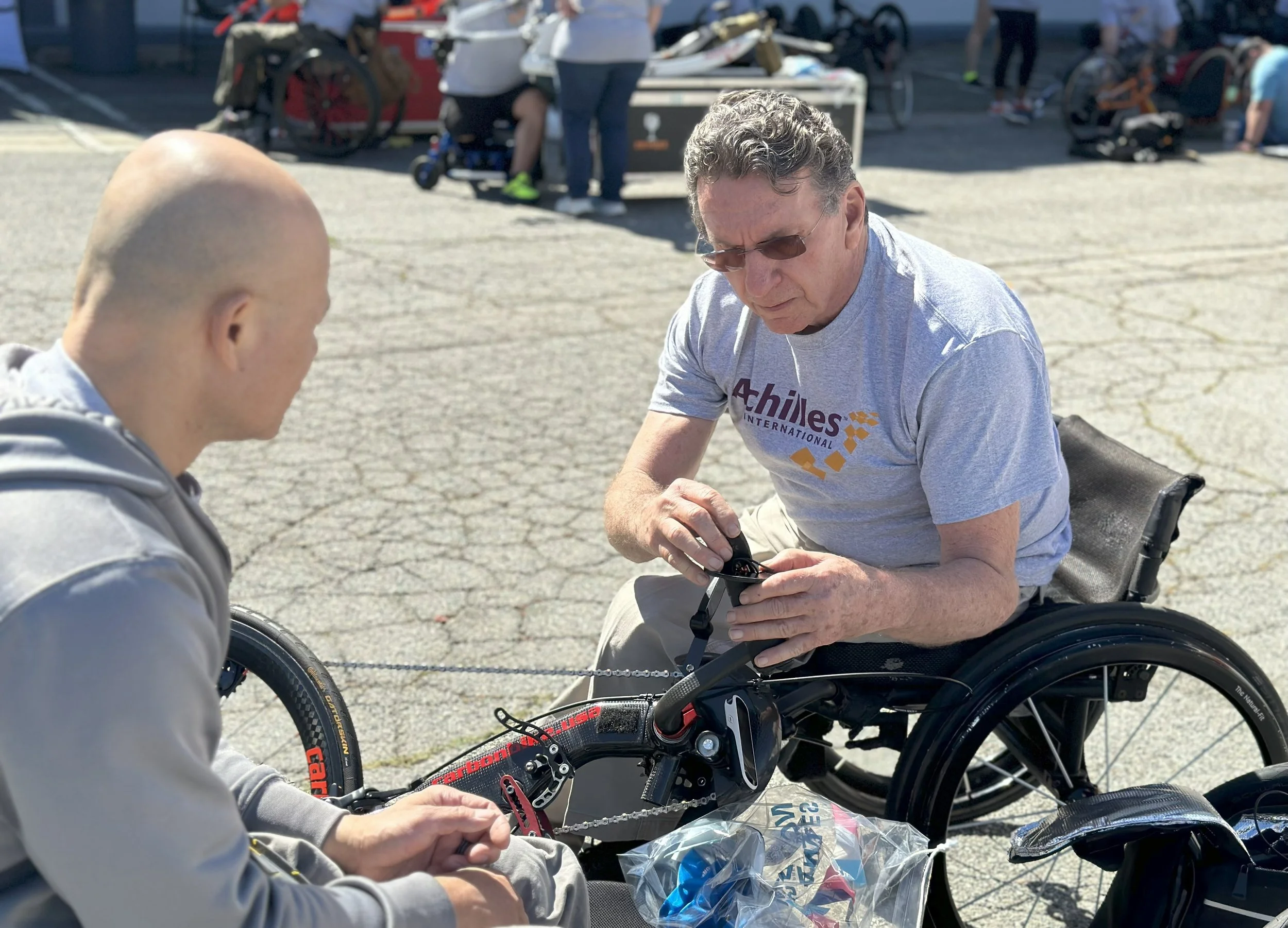Coaches Corner: How to Travel with Adaptive Equipment
We’ve all experienced the frustration of travel setbacks from delayed flights to lost luggage. Now, imagine navigating those challenges while carrying nearly 100 pounds of adaptive racing equipment!
While the situation may seem stressful, there are ways to ensure a seamless experience for a successful race day. With a solid plan and a few extra precautions, it becomes just another part of race preparation. See below for some key tips from Achilles NYC Metro Region Director, Francesco Magisano and NYC Adaptive Cycling Manager, Domenic Romano on how to make traveling with adaptive equipment as simple and efficient as possible.
1. Protect Your Equipment
The most important thing to do is protect your equipment when traveling to make sure nothing gets damaged. Handcycles, racing wheelchairs and mobility devices are often custom-fitted and expensive. Preventing damage is a top priority. Some ways to ensure your equipment is protected are to:
Disassemble Thoughtfully: Remove pedals, wheels, headrests, and any other detachable parts. Wrap each component in bubble wrap, foam, or towels to prevent scratches and dents. Also, save yourself time by marking key components like your seat post and handlebars with tape or a marker to indicate your preferred height and angle.
“If you're happy with the way the bike fits you beforehand, mark it,” Magisano advises. “That way, when you reassemble it, everything goes back to the exact setup you're used to.”
Use High-Quality Bike Bags or Hard Cases (when possible): For non-standard equipment like tandem bikes where cases are not commercially available, DIY packing solutions using cardboard, pipe insulation, pool noodles, and duct tape can offer significant protection.
“Bike boxes are not commercially available for tandem bikes, so you’ll have to get creative when it comes to wrapping it up and protecting it. Cardboard and duct tape will be your best friends,” Romano says.
Release Tire Pressure: Be sure to deflate your tires before flying to prevent blowouts due to changes in cabin pressure.
Remove and Carry Electronics Separately: If your bike uses electronic shifting, remove the battery and pack it in your carry-on. The same goes for any GPS units, lights, or other sensitive electronics.
“You want to be sure to take extra precautions with any carbon components, especially frames,” advises Magisano. “Carbon is super fragile and hard to repair.”
Inspect Everything Upon Arrival: As soon as you arrive, unpack your equipment and check for damage. Most airlines have a 24-hour window for reporting claims.
2. Plan Ahead and Be Prepared
Good planning starts well before race day. “Doing a little homework can save you major headaches later,” Magisano says.
Know Your Airline’s Policies: Most airlines allow mobility devices and adaptive equipment to fly free of charge if you’ve properly documented your needs. Call ahead or check their website for current policies, and bring documentation from a medical professional if necessary.
Think Beyond the Airport: What happens once you arrive? Most standard taxis, ride-sharing services or hotel shuttles aren’t built to accommodate large equipment like handcycles or tandem bikes. Book a larger vehicle or accessible van in advance to avoid scrambling for transport. Many cities offer specialized transport services for athletes or people with disabilities. Research what’s available at your destination and make reservations ahead of time.
3. Bring Extra Parts and Tools
Nothing’s worse than arriving at your race destination only to discover something’s loose, bent, or broken and realizing you don’t have the tools to fix it.
Pack a full-size set of hex keys, screwdrivers, and any specialty tools your equipment requires. Avoid relying solely on a mini multitool, which may not provide the leverage or size you need for proper adjustments.
Bring spare tubes, extra batteries, zip ties, a compact air pump, and any replacement parts that commonly wear out or fail.
“People often don’t think about bringing extra tools until they get to the start line and realize something on their bike needs to be adjusted,” notes Magisano. “A little prep can save your race.”
4. Don’t Forget to Tune Up Your Bike Again Before Race Day
Travel can jostle your equipment more than you expect. A pre-race tune-up is always a must, even if your bike was in perfect condition before you packed it.
“Traveling can mess up your equipment, so it’s important that everything is in good, working order before you just jump on and get going right before the race,” says Romano. “A quality tune up can ensure that everything is working properly and prevent issues while you’re out on the course.”
Are you racing a major marathon where Achilles has a presence? Remember, the Achilles team is always here to help.
Learn more about different types of adaptive racing equipment and find the best option for you.
Athletes tuning up their handcycles.

